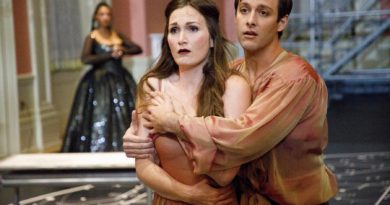From 1933 to 2021: Ted Staunton and Josh Rosen’s compelling new graphic novel challenges today’s youth to pick up The Good Fight

“1933 seems a long way behind us, but some of its darkness still lurks, here and now.”
Ted Staunton, prolific Canadian children’s book author, is discussing The Good Fight, his new graphic novel with comic artist and illustrator Josh Rosen. Here, he isolates an important – but by no means the only – hook of this substantial and eye-catching work for young readers.
The plot of The Good Fight reaches its climax during 1933’s Riot at Christie Pits in Toronto. The riot, which spilled out of Christie Pits and drew in more than 10,000 participants and spectators, was sparked by a swastika flag flown by Nazi-sympathizing youth at a public baseball game. Because the incident is not well-known and fundamentally challenges our sense of the multicultural Toronto of 2021, this is fertile ground for fiction. As he discloses in an Author’s Note at the start, this story has a personal connection for Stanton: his grandfather WJ Stewart CBE was mayor at the time and one of the forces pushing back at that bigoted darkness of 1933. But where Stanton and Rosen take this topic is not quite where you might expect.
The Good Fight is not a treatise on the origins and development of what has been called the worst anti-Semitic riot in the history of Canada. Instead, it’s a human-scale story of three immigrant children whose specific, personal dramas intersect the larger, uglier forces shaping this moment in history. The children come from families who are just scraping by in depression-era Toronto. Sid is a serious Jewish boy struggling with a stern and sad widowed father and an unjust world that sets him off in fits of unfocused anger. Plug is his happy-go-lucky, musically-gifted Italian best friend; and Rosie is Plug’s wise beyond-her-years younger sister, whose understanding of photography will come in handy at the close of the story.
Throughout the graphic novel, we see the three children and their parents on the receiving end of systemic racial and class-based discrimination and humiliation in Protestant-dominated Toronto. While their parents engage politically, we watch the kids’ thwarted efforts to earn money to support their families and – dream of dreams – do the simple kinds of things that kids do for fun. These simple needs and desires lead the children to petty thievery, with consequences that escalate quickly to violence, legal jeopardy and a deep, despairing powerlessness caused by the manipulation and threats of adults. The plot reaches a satisfying – and surprising – climax amidst the Riot.

Rosen’s art style is clean, cartoony and energetic: what he calls a deliberate effort to “walk the line between giving the book a look that felt realistic and grounded in the period, while also keeping it expressive and appealing to a modern young audience.” He explains that the main characters’ looks “all had their origins in the conversations I had with Ted early on.” As the showman of the trio, Josh gave Plug “a bright, boisterous look.” On the other hand, “because Sid is such a self-serious character, at times it became important to do little things to make sure the reader wouldn’t forget how young he was. Like making sure Sid was always wearing shorts. Quick visual reminders that these are still kids dealing with a situation that is out of their league.” Rosie is the most skeptical (and the most adult) of the three, “so I tried to bring that out in her having a bit more of a conservative dress style, being a bit more buttoned down. Unlike Plug, she’s more of an observer than a performer.”
Staunton and Rosen’s collaboration began with defining the characters, but pervaded the entire process of creation. It has yielded a warm and genuine mutual admiration. “Ted was an extremely generous collaborator from a very early stage,” recalls Josh. Ted, in turn, notes that “Josh was amazingly flexible and patient. It was a ton of work for him” to fuse Staunton’s story and words with dynamic imagery. Amazingly, this was the first graphic novel for both men. “Writing the script was way different from standard prose,” laughs Ted. For Josh, it was an enormous undertaking to tackle some 200 pages with five to seven illustrations on most pages: “I don’t know if it was necessarily WISE to take on such a lengthy project as my first graphic novel,” he smiles. “But I love long-form narratives, and I wanted to do the story justice, so it kind of demanded a bigger page count.”
Ted recalls the process beginning with his initial script for 25-page chapters with “some combination of dialogue, narration, and visual suggestions for Josh.” Josh explains that he translated those into rough layouts by “breaking down how many pages and panels a given scene required, which moments deserved half- or full-page spreads, what the acting or ‘camera’ work of a given scene needed to be. Really, the core of the comics process took place at that stage, and I was grateful for having been given a tremendous amount of trust in how I chose to translate the script to pages.” Finally, recalls Ted, “Josh’s roughs would suggest more text and art changes.” “We were in touch throughout the process,” recalls Josh, “even in the final art stage. So the whole thing felt highly collaborative throughout.”

The two men’s new – and true – collaboration results in vivid, winning characters whom we care for as the stakes rise. The core story – the good fight – pursued by Sid, Plug and Rosie is relatable, and makes a compelling through-line for the graphic novel. And at the same time, The Good Fight conjures a wonderfully specific sense of time and place. I was surprised – and delighted – at how uncompromisingly immersive the backdrop is. The story prominently features multiple Toronto neighborhood names and locations, Toronto newspapers like the Telegram and Daily Star, historical figures such as Mayor WJ Stewart – not to mention period songs and even lessons in orchestrated pickpocketing by a “whiz mob” where different members take on the role of “stall man” “mechanic” and “duke man”.
Staunton comes by his fascination with history honestly: “Grandpa Stewart himself was a history guy: as mayor he also initiated the restoration of Fort York and later served as chair of the Toronto Historical Board.” It “kind of runs in the family,’ Staunton admits. “I arrived quite late in my parents’ lives, so I grew up with anecdotes about a city long gone.” He enthusiastically augmented an already strong basic sense of the city’s past with deeper research, which ranged from “music, film, and books about the era” to the City of Toronto archives (“a delight”) and finally to “off-beat sources, like Eaton’s catalogues from back in the day.”
Of course, each element of Staunton’s research challenged Rosen to depict it. So Rosen pursued a parallel immersive process: “I actually spent a bit of time hunting through used book stores, picking up photo books with titles like ‘Toronto Through the Ages’ and things like that. I took several trips to the City of Toronto Archives and Ontario Jewish Archives with my sketchbook, printing out photos, looking at microfilm, and making sketches based on any reference material I couldn’t take with me. I looked at a lot of period reference for the book’s key locations (Willowvale Park, Kensington Market, Balmy Beach, Sunnyside) but also just general photos of 1930s kids, 1930s fashion and 1930s architecture. Not all of that made it into the book, but it all helped to immerse me in the look and feel of the period.”

So effectively realized is Staunton and Rosen’s 1933 Toronto that it will likely feel alien to many readers. The characters and their challenges are recognizable and compelling, but readers will need to invest imaginative energy to acclimatize to the setting. This is an undeniable plus: there is world-building on the order of a great fantasy graphic novel going on here. And unifying that world is Rosen’s gorgeous colour palette, which he describes as an “almost ‘faux sepia’ tone, despite using a wider palette. So lots of browns and greys and yellows, and dull pinks. And a generally lower saturation, to try to give it a bit of a look of something from another era, like looking at old photographs.”
Rosen smiles as he recalls becoming so skilled in conjuring that atmosphere that, “at a certain point, Andrea – our art director – had to pull me aside and go, ‘Well, you should still have SOME high saturation colours. It is a kids’ book after all!’” The one deliberate exception to these naturalist colours is Rosen’s skilled “use of brighter reds to represent Sid’s growing anger. Unfocused anger is a big theme in the book, culminating in the riots at the book’s climax. And I wanted to represent that visually. So we have the occasional little flashes of red, that grow in intensity as the story goes on.”
When you put all of its elements together, The Good Fight is a richly visualized period piece with compelling characters and resonant, relevant themes. The different plot threads come together neatly to resolve the story at the moment of the Riot at Christie Pits– but the overall ending is anything but neat. Sid, Plug and Rosie rise to the occasion and do the most right things they possibly can in this moment. But in the bigger picture, a sobering Epilogue makes it clear that they remain trapped in larger and unyielding tides of history. I ask Stanton, “is that what the Good Fight really is?” He nods affirmatively: “History doesn’t end, and neither does evil, or our mistakes. The Good Fight will always go on, often, sadly, over the same problems. But while we may not be able to stem the tides of history, we can help channel the flow.”

Rosen elaborates on the balancing act he and Staunton have accomplished in creating this deeply historical yet transcendent work – and releasing it into a world rife with cultural and political division exacerbated by the devastating endurance contest of the COVID-19 pandemic: “Despite this being a historical graphic novel, it obviously feels very much of our times. And the reason we felt driven to share a story like this was out of fear of a similar moment repeating. In times of great uncertainty, like it was in the 1930s, and like it seems to be now, there can be a lot of appeal in easy answers. Hate is easy. Blaming people who seem different from you is easy.”
Toronto in 2021 is staggeringly multicultural – completely unlike the predominantly white Toronto of 1933, but nonetheless, “you can understand how we can get to a place like what happened in Christie Pits. The hope is that through the book, and through sharing the story again, we can remind readers that we’ve been through this before. And that we overcame, we made it through by working together and supporting each other as a community. So hopefully, our book can reach a lot of people, and hopefully that message comes across.”
© Scott Sneddon, SesayArts Magazine, 2021
About The Author
Scott Sneddon
Scott Sneddon is Senior Editor on SesayArts Magazine, where he is also a critic and contributor.
Visit About Us > Meet the Team to read Scott’s full bio …




